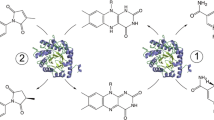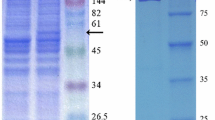Abstract
The xanthine dehydrogenase of Clostridium acidiurici and C. cylindrosporum was assayed with methyl viologen as acceptor. In C. acidiurici the basal activity level was about 0.3 μmol/min x mg of protein. Cells grown on uric acid in the presence of 10-7 M selenite showed a 14-fold increase in xanthine dehydrogenase activity, which decreased with higher selenite concentrations (10-5 M). The supplementation with 10-7 M molybdate or tungstate was without effect. High concentrations of tungstate decreased the xanthine dehydrogenase if selenite was also present. In comparison, high concentrations of molybdate affected only a small decrease in activity level at the optimal concentration for selenite and relieved to some degree the inhibitory effect of 10-5 M selenite. With hypoxanthine and xanthine as substrates for growth again only the addition of selenite was necessary to show a similar increase in xanthine dehydrogenase activity.
C. acidiurici could be grown in a mineral medium. Both xanthine dehydrogenase and formate dehydrogenase exhibited the highest level of activity if selenite and tungstate were present in that medium.
In C. cylindrosporum the basal activity level of xanthine dehydrogenase was about 0.95 μmol/min x mg of protein. The addition of 10-7 M selenite to the growth medium increased the activity level about 3-fold, but the highest level (3.7 U/mg) was reached if 10-7 M molybdate was also added. The presence of tungstate resulted in a decreased enzyme activity.
Similar content being viewed by others
References
Andreesen, J. R.: Role of selenium, molybdenum and tungsten in anaerobes. In: Anaerobiosis and anaerobic infection (Proceedings of the Symposia held at the XII. International Congress of Microbiology) (G. Gottschalk, N. Pfennig, H. Werner, eds.). Stuttgart: Gustav Fischer-Verlag 1979
Barker, H. A., Beck, J. V.: The fermentative decomposition of purines by Clostridium acidi-urici and Clostridium cylindrosporum. J. Biol. Chem. 141, 3–27 (1941)
Barker, H. A., Beck, J. V.: Clostridium acidi-urici and Clostridium cylindrosporum, organisms fermenting uric acid and some other purines. J. Bacteriol. 43, 291–304 (1942)
Barker, H. A., Peterson, W. H.: The nutritional requirements of Clostridium acidi-urici. J. Bacteriol. 47, 307–308 (1944)
Beisenherz, G., Bolze, H. J., Bücher, T., Czok, R., Garbade, H. K., Meyer-Arendt, E., Pfleiderer, G.: Diphosphofructose-Aldolase, Phosphoglyceraldehyde-Dehydrogenase, Milchsäure-Dehydrogenase, Glycerophosphat-Dehydrogenase und Pyruvat-Kinase aus Kaninchenmuskulatur in einem Arbeitsgang. Z. Naturforsch. 8b, 555–577 (1953)
Bradshaw, W. H., Barker, H. A.: Purification and properties of xanthine dehydrogenase from Clostridium cylindrosporum. J. Biol. Chem. 235, 3620–3629 (1960)
Bray, R. C.: Molybdenum iron-sulfur flavin hydroxylases and related enzymes. In: The Enzymes (3rd Ed.) (P. Boyer, ed.), Vol. 12, pp. 299–419. New York: Academic Press 1975
Bryant, M. P.: Commentary on the Hungate technique for culture of anaerobic bacteria. Am. J. Clin. Nutr. 25, 1324–1328 (1972)
Callis, G. E., Wentworth, R. A. D.: Tungsten versus molybdenum in models for biological systems. Bioinorg. Chem. 7, 57–70 (1977)
Cone, J. E., Martin Delrio, R., Davis, J. N., Stadtman, T. C.: Chemical characterization of selenoprotein component of clostridial glycine reductase. Identification of selenocysteine as organoselenium moiety. Proc. Natl. Acad. Sci. 73, 2659–2663 (1976)
Coughlan, M. P.: On the origin of the cyanolysable sulphur in molybdenum iron/sulfur flavin hydroxylases. FEBS Lett. 81, 1–6 (1977)
Dilworth, G. L., Bandurski, R. S.: Activation of selenate by adenosine 5′-triphosphate sulphurylase from Saccharomyces cerevisiae. Biochem. J. 163, 521–529 (1977)
Edmondson, D., Massey, V., Palmer, G., Beacham, L. M., Elion, G. B.: The resolution of active and inactive xanthine oxidase by affinity chromatography. J. Biol. Chem. 247, 1597–1604 (1972)
Elliott, B. B., Mortenson, L. E.: Transport of molybdate by Clostridium pasteurianum. J. Bacteriol. 124, 1295–1301 (1975)
Elliott, B. B., Mortenson, L. E.: Molybdenum storage component from Clostridium pasteurianum. In: Recent developments in nitrogen fixation (W. Newton, J. R. Postgate, C. Rodriguez-Barrueco, eds.), pp. 205–217. London: Academic Press 1977
Enoch, H. G., Lester, R. L.: The purification and properties of formate dehydrogenase and nitrate reductase from Escherichia coli. J. Biol. Chem. 250, 6693–6705 (1975)
Forstrom, J. W., Zakowski, J. J., Tappel, A. L.: Identification of the catalytic site of rat liver glutathione peroxidase as selenocysteine. Biochemistry 17, 2639–2644 (1978)
Ganther, H. E.: Reduction of the selenotrisulfide derivative of glutathione to a persulfide analog by glutathione reductase. Biochemistry 10, 4089–4098 (1971)
Günther, W. H. H.: Methods in selenium chemistry. III. The reduction of diselenides with dithiothreitol. J. Org. Chem. 32, 3931–3933 (1967)
Hochstein, L. I., Dalton, B. P.: The hydroxylation of nicotine: the origin of the hydroxyl oxygen. Biochem. Biophys. Res. Commun. 21, 644–648 (1965)
Hunt, A. L., Hughes, D. E., Lowenstein, J. M.: The hydroxylation of nicotinic acid by Pseudomonas fluorescens. Biochem. J. 69, 170–173 (1958)
Imhoff, D., Andreesen, J. R.: Nicotinic acid hydroxylase from Clostridium barkeri: selenium-dependent formation of active enzyme. FEMS Microbiol. Lett 5, 155–158 (1979)
Krenitsky, T. A., Neil, S. M., Elion, G. B., Hitchings, G. H.: A comparison of the specificities of xanthine oxidase and aldehyde oxidase. Arch. Biochem. Biophys. 150, 585–599 (1972)
Leonhardt, U., Andreesen, J. R.: Some properties of formate dehydrogenase, accumulation and incorporation of 185W-tungsten into proteins of Clostridium formicoaceticum. Arch. Microbiol. 115, 277–284 (1977)
Ljungdahl, L. G.: Tungsten, a biologically active metal. Trends in biochem. Sci. 1, 63–65 (1976)
Ljungdahl, L. G., Andreesen, J. R.: Tungsten, a component of active formate dehydrogenase of Clostridium thermoaceticum. FEBS Lett. 54, 279–282 (1975)
Ljungdahl, L. G., Andreesen, J. R.: Reduction of CO2 to acetate in homoacetate fermenting clostridia and the involvement of tungsten in formate dehydrogenase. In: Symposium on microbial production and utilization of gases (H2, CH4, CO) (H. G. Schlegel, G. Gottschalk, N. Pfennig, eds.), pp. 163–172. Göttingen: Akademie der Wissenschaften/E. Goltze-Verlag 1976
Ljungdahl, L. G., Andreesen, J. R.: Formate dehydrogenase, a selenium-tungsten enzyme from Chlostridium thermoaceticum. In: Methods in enzymology, Vol. 53 (S. P. Colowick, N. O. Kaplan, eds.), pp. 360–372. New York: Academic Press 1978
Lyon, E. S., Garrett, R. H.: Regulation, purification, and properties of xanthine dehydrogenase in Neurospora crassa. J. Biol. Chem. 253, 2604–2614 (1978)
Massey, V.: Iron-sulfur flavoprotein hydroxylases. In: Iron-sulfur proteins, Vol. I (W. Lovenberg, ed.), pp. 301–360. New York: Academic Press 1973
McCready, R. G. L., Din, G. A.: Active sulfate transport in Saccharomyces cerevisiae. FEBS Lett. 38, 361–363 (1974)
Olson, J. S., Ballou, D. P., Palmer, G., Massey, V.: The mechanism of action of xanthine oxidase. J. Biol. Chem. 249, 4363–4382 (1974)
Rabinowitz, J. C.: Intermediates in purine breakdown. In: Methods in enzymology, Vol. 6 (S. P. Colowick, N. O. Kaplan, eds.), pp. 703–713. New York: Academic Press 1963
Scherer, P. A., Thauer, R. K.: Purification and properties of reduced ferredoxin: CO2 oxidoreductase from Clostridium pasteurianum, a molybdenum iron-sulfur protein. Eur. J. Biochem. 85, 125–135 (1978)
Smith, S. T., Rajagopalan, K. V., Handler, P.: Purification and properties of xanthine dehydrogenase from Micrococcus lactilyticus. J. Biol. Chem. 242, 4108–4117 (1967)
Stadtman, T. C.: Selenium-dependent clostridial glycine reductase. In: Methods in enzymology, Vol. 53 (S. P. Colowick, N. O. Kaplan, eds.), pp. 373–382. New York: Academic Press 1978
Thauer, R. K., Fuchs, G., Schnitker, U., Jungermann, K.: CO2 reductase from Clostridium pasteurianum: molybdenum dependence of synthesis and inactivation by cyanide. FEBS Lett. 38, 45–48 (1973)
Thorneley, R. N. F.: A convenient electrochemical preparation of reduced methylviologen and a kinetic study of the reaction with oxygen using an anaerobic stopped-flow apparatus. Biochim. Biophys. Acta 333, 487–496 (1974)
Tweedie, J. W., Segel, I. H.: Specificity of transport processes for sulphur, selenium, and molybdenum anions by filamentous fungi. Biochim. Biophys. Acta 196, 95–106 (1970)
Vogels, G. D., van der Drift, C.: Degradation of purines and pyrimidines by microorganisms. Bacteriol. Rev. 40, 403–468 (1976)
Wagner, R., Andreesen, J. R.: Differentiation between Clostridium acidiurici and Clostridium cylindrosporum on the basis of specific metal requirements for formate dehydrogenase formation. Arch. Microbiol. 114, 219–224 (1977)
Whiteley, H. R.: The fermentation of purines by Micrococcus aerogenes. J. Bacteriol. 63, 163–175 (1952)
Whiteley, H. R., Douglas, H. C.: The fermentation of purines by Micrococcus lactilyticus. J. Bacteriol. 61, 605–616 (1951)
Woolfolk, C. A., Downard, J. S.: Distribution of xanthine oxidase and xanthine dehydrogenase specificity types among bacteria. J. Bacteriol. 130, 1175–1191 (1977)
Woolfolk, C. A., Downard, J. S.: Bacterial xanthine oxidase from Arthrobacter S-2. J. Bacteriol. 135, 422–428 (1978)
Author information
Authors and Affiliations
Rights and permissions
About this article
Cite this article
Wagner, R., Andreesen, J.R. Selenium requirement for active xanthine dehydrogenase from Clostridium acidiurici and Clostridium cylindrosporum . Arch. Microbiol. 121, 255–260 (1979). https://doi.org/10.1007/BF00425064
Received:
Issue Date:
DOI: https://doi.org/10.1007/BF00425064




